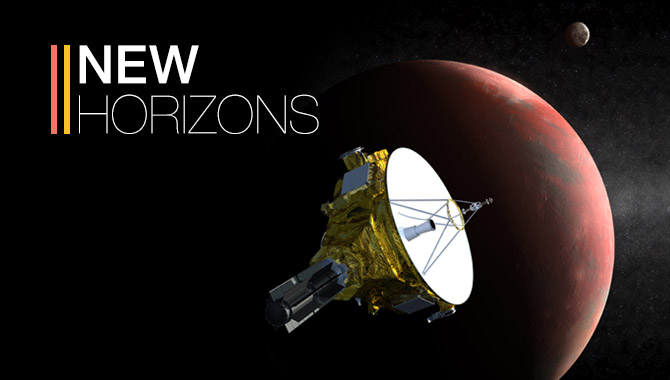
New Horizons expanded scientific understanding of Pluto and is now set to rendezvous with Ultima Thule in the Kuiper Belt.
Credit: NASA
After dramatically increasing scientific understanding of Pluto, the space probe is aimed for an encounter in the icy Kuiper Belt to return the most distant images ever taken.
The New Horizons space probe, which in July 2015 flew 7,800 miles above the surface of Pluto, made visual contact with its next target, Ultima Thule, for the first time this summer. Ultima Thule, which means “beyond the borders of the known world,” resides in the Kuiper Belt, an icy ring of dwarf planets and smaller debris remaining from the creation of the solar system.
By the time New Horizons travels the remaining 80 million miles and reaches Ultima Thule on January 1, it will be more than 1 billion miles beyond Pluto. In contrast to Pluto, which was discovered in 1930, Ultima Thule was discovered just four years ago and relatively little is known about it, including its exact orbit. To counter this, the team is using images taken by New Horizons’ scientific payload for optical navigation.
“We need those optical navigation images in order to home in,” said Alan Stern, New Horizons Principal Investigator, and associate vice president of the Space Science and Engineering Division at Southwest Research Institute (SwRI). “It’s just a dot in the distance, but finding it against the starfield lets us home in the exact arrival time and arrival place.”

Illustration of NASA’s New Horizons spacecraft encountering the Kuiper Belt object nicknamed Ultima Thule on Jan. 1, 2019.
Credits: NASA/JHUAPL/SWRI
“We are … traveling 32,000 miles per hour, 24/7, on our way to make the first flyby of an object out in the Kuiper belt. And we’re going to do that on January 1. We’re going to come right up to it, image it, find out what it’s made of, find out if it has moons and rings…,” said Stern, speaking in a recent NASA Science Chat.
New Horizons launched in 2006, with a primary mission to perform a six-month reconnaissance of Pluto and its moons. The mission greatly enhanced the scientific understanding of Pluto, which we now know has dunes of methane ice particles, rugged mountains, and sweeping plains. The spacecraft was in hibernation following the Pluto mission until June, when the team performed software updates and began preparations to rendezvous with Ultima Thule.
The Kuiper Belt is named after prominent astronomer and planetary scientist Gerard Kuiper. This icy ring comprises a sea of dwarf planets and smaller objects that formed at the birth of the solar system and now orbits, preserved at temperatures near absolute zero. Although it was first theorized in the 1940s and 1950s, it wasn’t until the 1990s that scientists had the technology to confirm its existence.
“Pluto is the biggest and brightest of a whole sea of objects formed at the birth of the solar system,” Stern said. “Beyond the orbit of Neptune is this vast region, bigger than everything else.” More than 1,000 items have been identified in the belt, of the approximately 100,000 currently thought to exist.
Just as New Horizons’ mission to Pluto stretched the boundaries of science and engineering, the flight to Ultima Thule will as well, for myriad reasons.
“[Ultima Thule] hasn’t been known to us for very long. It was discovered in 2014. So that means that the orbit is not very well characterized and that’s why we’re doing optical navigation, continuously looking to make sure we know the point in space that we want to target,” said Alice Bowman, New Horizons Missions Operation Manager, Applied Physics Laboratory.
“[Ultima Thule] is also much smaller than Pluto. Actually, we don’t know how big it is. We don’t know, really, the shape of it. But we think it’s about 23 or so miles in diameter. And we are trying to fly by much closer to Ultima Thule than we flew by Pluto,” Bowman said.
New Horizons will come within about 2,200 miles of Ultima Thule. It will be the farthest exploration of a planetary body to date and the photos the probe sends back to Earth will be the most distant images ever taken. A signal from mission control requires more than six hours to reach the spacecraft now, including such critical information as that needed for a course correction planned for October 3.
“Everything about this flyby is tougher,” Stern said. “The lighting levels are lower. Onboard the spacecraft, it’s three years older. Its fuel levels are lower. Its power levels are lower. It takes longer to communicate back and forth to the Earth. The navigation challenges are tougher. We think we are up to it as a team and as a spacecraft. We were designed to do exactly this—to go exploring beyond Pluto—but it’s going to be an adventure.”
The challenges, though, are well worth it to increase scientific understanding of this vast area that contains remnants from the creation of the solar system, preserved for billions of years in extreme cold.
“It’s our best window into the origin of the solar system and into our own past that we’ve ever had. It’s amazing,” Stern said.
“This is debris left over from our initial cloud collapse that created the solar system,” said James Green, NASA Chief Scientist. “We are going back in time by going out to the farthest reaches of the solar system to really understand what these objects are like. This is tremendously exciting for us.”









